The Minister of Economy, Luis Caputohe insisted on Tuesday with the possibility of implementing a plan that seeks to consolidate the endogenous dollarizationa process where Argentines adopt the green ticket by their own decision, without suppressing the weight. Behind this possibility hides, not to doubt it, the installation of an alleged climate of “Monetary stability” that the government estimates valuable to push its electoral chances.
This scheme, which It seems to want to evoke the convertibility of the 90s But with a renewed approach, it proposes a “coin competition” to remumding an economy with a circulating that barely covers half of the usual. However, the strategy is not exempt from controversies, both in the domestic and international sphere.
A central element of neoconverting, according to the PXQ consultancy, is the Implementation of a de facto exchange band inside the official band announced on April 11. While the original band ranges between $ 1,000 and $ 1,400, The “internal band” operates between $ 1,060 and $ 1,200and theoretically allows the government moderate the volatility of the official exchange rate, preventing sudden movements from moving to prices and feeding inflation.
The Government, through active interventions of the Central Bank (BCRA) and signals such as the increase in retentions to oilseed exports planned for June 30, tries to convince the market that the dollar will remain close to the floor of this sub-Banda, an approach that, according to the analysts consulted, reflects a “freely managed flotation” more than a free flotation.
Dollar, the band inside the band and dilemmas
This band inside the band, however, raises dilemmas. Although it allows to contain exchange volatility, limits the accumulation of reservessince the BCRA would only buy currencies if the exchange rate drills $ 1,000, a level that the market avoids, anticipating a rebound. This design collides with the goals of the agreement with the IMF, which requires accumulating US $ 4,300 million for June 2025.
The intervention in future dollar contracts in Rofex, presumably by the BCRA, reinforces this control strategy, Incentives the “Carry Trade” and maintains the exchange rate in a narrow range, but at the cost of compromising transparency and accumulation of currencies. To this strategy the government wants to add greater injection of dollars from the “savings of the Argentines.”
The president of the BCRA, Santiago Bausili, has defended this vision, arguing that the U $ 200,000 million that Argentines keep outside the system Formal – in effective, security boxes or unplaced accounts – are a key asset to boost the economy. “The dollars are there,” he said in a forum in Washington, underlining the intention of integrating them into the formal circuit. Measures such as price exhibition in pesos and dollars and foreign currency payments with debit cards, enabled since January 2025, are initial steps, although its adoption remains marginal, with less than 0.3% of dollars in dollars.
Fiscal discipline, reserves and geopolitical games
Neoconvertibility is sustained in a strict fiscal and monetary discipline. The Government argues that it eliminated the fiscal deficit and closed the monetary issuance sources, such as treasure financing and BCRA liabilities interests. This contraction of the pesos offer seeks to strengthen its value, forcing the private ones to Sell dollars to get local currency. The money laundering, which attracted more than US $ 20,000 million, and an agreement with the IMF for an additional US $ 20,000 million have strengthened reserves, allowing a scheme of mobile exchange bands that, in practice, is restricted by the internal band.
The exit of the exchange rate, negotiated with the IMF, reduced the gap between the official and free dollar without triggering a crisis, an achievement that Caputo stood out in the Expoefi. Criticizing the previous model, which generated a tourist deficit of US $ 997 million in March of this year, the minister promised a competitive exchange rate and a growth greater than 6% per year. However, the transfer of profits from the BCRA to the Treasury for $ 11.7 billion, aimed at canceling private debt, introduces a sign of monetary relaxation that could increase the pressure on the exchange rate and inflation.
Kristalina vs. Besent, the movie
The IMF, reluctant to endogenous dollarization, advocates A totally flexible exchange rateas in Peru or Uruguay, and see with concern the interventions of the BCRA and the monetary laxity. Analysts estimate that Holding neoconvertibility requires between US $ 50,000 YU $ S70,000 million in reserves, A difficult goal if the BCRA does not accumulate currencies inside the band. The tensions with the background are evident, but the United States Treasury seems to give Caputo a margin of maneuver. Fuentes suggest that Washington, possibly for geopolitical interests, tolerates that the minister explores roads outside the IMF guidelines, a support that could be interpreted as a political wink to maximize government electoral chances.
The risks are multiple. The reservations, vulnerable to external shocks such as a fall in agricultural exports, threatens the sustainability of the scheme. The internal band, although effective to control volatility, slows the accumulation of currencies, compromising key goals with the IMF and the reduction of country risk. In addition, the transition to a more dollarized economy could aggravate inequality, affecting the sectors that operate in pesos and face prices referenced in dollars.
Source: Ambito




